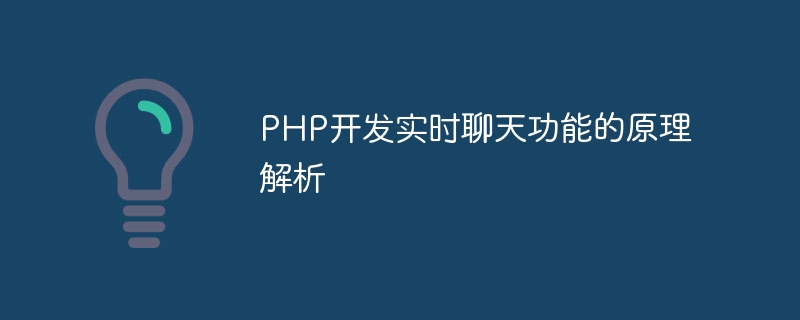Home >Backend Development >PHP Tutorial >Analysis of the principles of developing real-time chat function in PHP
Analysis of the principles of developing real-time chat function in PHP
- WBOYWBOYWBOYWBOYWBOYWBOYWBOYWBOYWBOYWBOYWBOYWBOYWBOriginal
- 2023-08-13 09:53:111609browse

Analysis of the principles of developing real-time chat function in PHP
In today's Internet era, real-time chat function has become one of the necessary functions for many websites and applications. Users can communicate and communicate with other users in real time through the real-time chat function. This article will analyze the principles of developing real-time chat function in PHP and provide code examples.
- Basic Principle
The basic principle of the real-time chat function is implemented through long polling (Long Polling) or WebSocket. Long polling means that the client sends a request to the server and keeps the connection open until the server has new data or the timeout period is reached before returning the result. WebSocket is a full-duplex communication protocol that can achieve two-way communication between the client and the server. - Long polling to implement real-time chat function
The following is a simple PHP code example to implement real-time chat function:
// 服务器端接收客户端消息并返回
function poll($lastMessageId)
{
$timeout = 30; // 设置超时时间
$start = time(); // 记录开始时间
while (time() - $start < $timeout) {
// 检查是否有新的消息
if ($newMessage = checkNewMessage($lastMessageId)) {
return $newMessage;
}
usleep(1000000); // 休眠一秒钟,降低服务器负载
}
return null; // 超时返回null
}
// 客户端请求示例
$lastMessageId = $_GET['lastMessageId'];
$newMessage = poll($lastMessageId);
if ($newMessage) {
echo json_encode($newMessage);
} else {
header("HTTP/1.1 304 Not Modified"); // 没有新消息
}- WebSocket to implement real-time chat function
The following is a PHP code example that uses the Ratchet library to implement the real-time chat function:
require_once 'vendor/autoload.php'; // 引入Ratchet库
use RatchetMessageComponentInterface;
use RatchetConnectionInterface;
class Chat implements MessageComponentInterface
{
protected $clients;
public function __construct()
{
$this->clients = new SplObjectStorage;
}
public function onOpen(ConnectionInterface $conn)
{
$this->clients->attach($conn);
echo "New connection! ({$conn->resourceId})
";
}
public function onMessage(ConnectionInterface $from, $msg)
{
echo sprintf('Received message from %d: %s', $from->resourceId, $msg) . "
";
foreach ($this->clients as $client) {
if ($client !== $from) {
$client->send($msg);
}
}
}
public function onClose(ConnectionInterface $conn)
{
$this->clients->detach($conn);
echo "Connection {$conn->resourceId} has disconnected
";
}
public function onError(ConnectionInterface $conn, Exception $e)
{
echo "An error has occurred: {$e->getMessage()}
";
$conn->close();
}
}
$server = IoServer::factory(
new HttpServer(
new WsServer(
new Chat()
)
),
8080
);
$server->run();Through the above code example, we can easily implement the real-time chat function through long polling or WebSocket. Developing real-time chat functions in PHP can help us improve user experience and promote communication and interaction between users. Whether it is long polling or WebSocket, they are both effective solutions, and developers can choose the appropriate implementation method according to specific needs.
The above is the detailed content of Analysis of the principles of developing real-time chat function in PHP. For more information, please follow other related articles on the PHP Chinese website!

